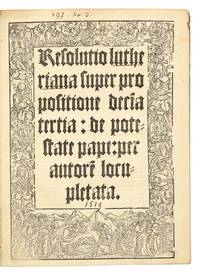Hardcover
1720 · France
by Madame de La Fayette (Marie-Madeleine Pioche de La Vergne, Comtesse de La Fayette) (1634-1693)
France: c, 1720. Hardcover. Fine. Bound in contemporary French calf (some scrapes and stains, repairs to corners, edges, and spine), the spine tooled in gold and with gilt label gilt turn-ins. The boards feature central armorial stamps of the De Niquet family. This copy was likely from the collection of Antoine-Joseph de Niquet (1701-1794). An early manuscript copy of this biography of the English princess in exile Henrietta D'Angelterre (Henrietta of England), daughter of Charles I and sister of Charles II. The book – a unique blend of memoir, portraiture, and courtly narrative- was written at Henrietta’s request by her friend, the countess Madame De La Fayette, author of the first French novel, “La Princesse de Clèves”(1678).
A neat, highly-legible copy in brown ink. Light shine-through in the text, a little heavier toward the end, not impairing legibility. Pages 20-21 with very light residual ink smears, pp. 104-105 with two tallow stains, a few other insignificant marks. All edges gilt.
During the English Civil War, the two-year-old Henrietta fled to France with her mother, who founded the Convent of Sainte-Marie de Chaillot, which sheltered part of the exiled English court. Madame de La Fayette was a regular visitor at Chaillot, and the young Henrietta would wait on her there, with the two eventually becoming close friends. In 1661 Henrietta married her cousin, Philippe I, Duke Of Orleans, and was instrumental in negotiating the Secret Treaty of Dover in June 1670. Later that month, as detailed in the manuscript, she died suddenly at the age of 26.
The author died in 1693 and the biography remained in manuscript until 1720, when it was published in Amsterdam. Textually, this manuscript generally conforms to the published version but there are some differences, suggesting that this manuscript predates the published edition.
La Fayette’s “Secret History” is not a formal or comprehensive biography but rather a semi-fictionalized account shaped directly by Princess Henrietta herself. Madame de la Fayette was encouraged by the princess to write it as a sort of memoir interwoven with court gossip, personal recollections, and character portraits. It was originally intended as an entertaining chronicle of Henrietta’s personal experiences, particularly her romantic entanglements and courtly intrigues, not as a serious historical document.
Despite its informal beginnings, the “Secret History” offers an intimate and often sympathetic view of Henrietta’s life. Henrietta herself had a direct hand in shaping its narrative—dictating events, reviewing drafts, and even writing portions of the text. The aim was to create a lively and engaging story, and the result is a work that reflects Henrietta’s charm, wit, and emotional complexity. It is filled with anecdotes about her relationships, especially her famous but ultimately innocent flirtation with the Comte de Guiche, which stirred much speculation and scandal at the French court. Henrietta’s marriage is depicted as fraught with difficulty. Her husband, Philippe, is portrayed as vain, jealous, and unsympathetic.
Although some critics have dismissed the Secret History as trivial or overly concerned with “gallantries,” this judgment fails to appreciate the emotional sincerity of the work. Henrietta’s desire to tell her own story, particularly her struggles with court gossip and her difficult marriage to Philippe, Duc d’Orléans, gives the narrative personal depth.
Madame de la Fayette portrays Henrietta not simply as a romantic heroine but as a woman of intelligence and independent spirit. Her key diplomatic role in the Treaty of Dover, acting as a liaison between her brother Charles II of England and her brother-in-law Louis XIV of France, is put forth as an example of Henrietta’s political shrewdness.
Henrietta's sudden death casts a tragic shadow over the book. While rumors of poisoning swirled after her demise, Madame de la Fayette, who was present at her deathbed, did not believe them. Instead, she concluded the manuscript with a poignant account of Henrietta’s final moments, leaving the rest of the story unfinished:
"Always holding the crucifix to her mouth, death alone made her part with it, as strength left her, she dropped it. She lost speech and Life quasi-simultaneously, her agony was but a moment, and after two or three little convulsive movements in the mouth, she expired at two thirty in the morning, nine hours after she began to feel unwell. (Inventory #: 5276)
A neat, highly-legible copy in brown ink. Light shine-through in the text, a little heavier toward the end, not impairing legibility. Pages 20-21 with very light residual ink smears, pp. 104-105 with two tallow stains, a few other insignificant marks. All edges gilt.
During the English Civil War, the two-year-old Henrietta fled to France with her mother, who founded the Convent of Sainte-Marie de Chaillot, which sheltered part of the exiled English court. Madame de La Fayette was a regular visitor at Chaillot, and the young Henrietta would wait on her there, with the two eventually becoming close friends. In 1661 Henrietta married her cousin, Philippe I, Duke Of Orleans, and was instrumental in negotiating the Secret Treaty of Dover in June 1670. Later that month, as detailed in the manuscript, she died suddenly at the age of 26.
The author died in 1693 and the biography remained in manuscript until 1720, when it was published in Amsterdam. Textually, this manuscript generally conforms to the published version but there are some differences, suggesting that this manuscript predates the published edition.
La Fayette’s “Secret History” is not a formal or comprehensive biography but rather a semi-fictionalized account shaped directly by Princess Henrietta herself. Madame de la Fayette was encouraged by the princess to write it as a sort of memoir interwoven with court gossip, personal recollections, and character portraits. It was originally intended as an entertaining chronicle of Henrietta’s personal experiences, particularly her romantic entanglements and courtly intrigues, not as a serious historical document.
Despite its informal beginnings, the “Secret History” offers an intimate and often sympathetic view of Henrietta’s life. Henrietta herself had a direct hand in shaping its narrative—dictating events, reviewing drafts, and even writing portions of the text. The aim was to create a lively and engaging story, and the result is a work that reflects Henrietta’s charm, wit, and emotional complexity. It is filled with anecdotes about her relationships, especially her famous but ultimately innocent flirtation with the Comte de Guiche, which stirred much speculation and scandal at the French court. Henrietta’s marriage is depicted as fraught with difficulty. Her husband, Philippe, is portrayed as vain, jealous, and unsympathetic.
Although some critics have dismissed the Secret History as trivial or overly concerned with “gallantries,” this judgment fails to appreciate the emotional sincerity of the work. Henrietta’s desire to tell her own story, particularly her struggles with court gossip and her difficult marriage to Philippe, Duc d’Orléans, gives the narrative personal depth.
Madame de la Fayette portrays Henrietta not simply as a romantic heroine but as a woman of intelligence and independent spirit. Her key diplomatic role in the Treaty of Dover, acting as a liaison between her brother Charles II of England and her brother-in-law Louis XIV of France, is put forth as an example of Henrietta’s political shrewdness.
Henrietta's sudden death casts a tragic shadow over the book. While rumors of poisoning swirled after her demise, Madame de la Fayette, who was present at her deathbed, did not believe them. Instead, she concluded the manuscript with a poignant account of Henrietta’s final moments, leaving the rest of the story unfinished:
"Always holding the crucifix to her mouth, death alone made her part with it, as strength left her, she dropped it. She lost speech and Life quasi-simultaneously, her agony was but a moment, and after two or three little convulsive movements in the mouth, she expired at two thirty in the morning, nine hours after she began to feel unwell. (Inventory #: 5276)
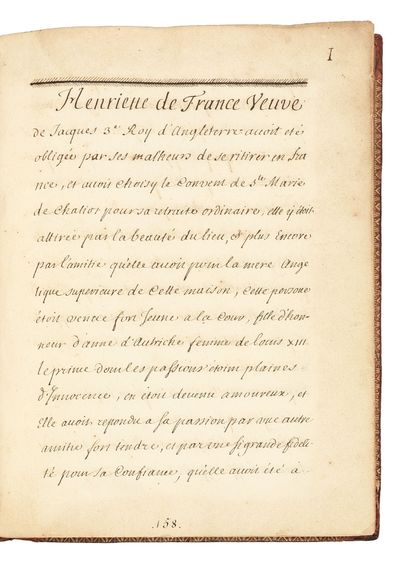
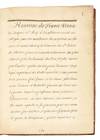

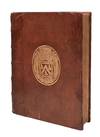
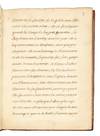
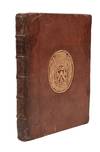
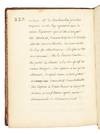

![The book of common prayer, and administration of the sacraments, and other rites and ceremonies of the church, according to the use of the Church of Ireland: Together with the Psalter or Psalms of David, pointed as they are to be sung or said in churches. [Bound with, as issued:] A New version of the Psalms of David, fitted to the tunes used in churches. By N. Brady, D.D. chaplain in Ordinary, and N. Tate, Esq; poet lauraet [sic] to His Majesty](https://d3525k1ryd2155.cloudfront.net/h/539/756/1693756539.0.m.jpg)
